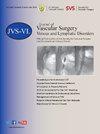Efficacy of ultrasound-guided microwave ablation for vascular malformations in children
IF 2.8
2区 医学
Q2 PERIPHERAL VASCULAR DISEASE
Journal of vascular surgery. Venous and lymphatic disorders
Pub Date : 2025-03-25
DOI:10.1016/j.jvsv.2025.102240
引用次数: 0
Abstract
Objective
The aim of this study was to report our center’s experience in treating pediatric vascular malformations using ultrasound-guided microwave ablation.
Methods
Twenty-two symptomatic children with vascular malformations underwent ultrasound-guided microwave ablation. All patients received ultrasound follow-up after microwave ablation, whereas magnetic resonance imaging follow-up was conducted depending on the disease’s condition. The Visual Analog Scale and the PedsQL4.0 Chinese Version was utilized to assess the changes in pain severity, limb motion evaluation, and quality of life before and after treatment.
Results
The study included 22 cases, comprising four arteriovenous malformations, nine venous malformations, two diffuse microcystic lymphatic malformations, two cases of Klippel-Trenaunay syndrome, and five cases of fibro adipose vascular anomaly. All children presented with pain at the affected site (22 cases; 100%). The malformations were located in the limbs in 17 cases (77%), subcutaneous and intramuscular tissues of the buttocks in one case (4.5%), subcutaneous tissue of the abdominal wall in one case (4.5%), and retroperitoneal in three cases (14%). All 22 patients (100%) experienced pain. Additionally, 20 cases (91%) exhibited swelling at the affected site or developed swelling after physical activity. Limb hypertrophy was observed in five cases (23%), whereas another five cases (23%) showed signs of limb atrophy. Joint mobility restrictions were present in four cases (18%). Among these 22 patients, 17 cases (77.3%) experienced complete resolution of pain and local lesion appearance changes, whereas four cases (18.2%) reported pain relief. However, in one case (4.5%) of Klippel-Trenaunay syndrome, postoperative improvement was observed at the treatment site, but a new centripetal malformation developed within the treated region. This patient subsequently underwent surgical intervention, resulting in an improvement in clinical symptoms. The pre-treatment malformation volume was 209.85 ± 343.17 cm3, which reduced to 32.95 ± 66.04 cm3 1 year after ablation. The volume reduction was statistically significant (t = 2.374; P = .026; P < .05), with an average volume reduction rate of 85.51%. No major complications were found, such as nerve damage or skin burns.
Conclusions
Ultrasound-guided microwave ablation is a relatively safe and effective technique for treating pediatric vascular malformations. Further multicenter studies are recommended to validate these findings.
超声引导下微波消融治疗儿童血管畸形的疗效观察。
目的:介绍超声引导下微波消融治疗小儿血管畸形的经验。方法:对22例有症状的血管性畸形患儿行超声引导下的微波消融治疗。所有患者在微波消融后均行超声随访,并根据病情进行MRI随访。采用视觉模拟量表(VAS)和PedsQL4.0中文版评估治疗前后疼痛严重程度、肢体运动评价和生活质量的变化。结果22例,其中动静脉畸形(AVM) 4例,静脉畸形(VM) 9例,弥漫性微囊性淋巴畸形(LM) 2例,Klippel-Trenaunay综合征(K-T综合征)2例,纤维脂肪血管异常(FAVA) 5例。所有患儿均表现为受累部位疼痛(22例,100%)。畸形位于四肢17例(77%)、臀部皮下及肌内组织1例(4.5%)、腹壁皮下组织1例(4.5%)、腹膜后3例(14%)。22例患者(100%)均出现疼痛。此外,20例(91%)在受影响部位出现肿胀或在体育活动后出现肿胀。肢体肥大5例(23%),肢体萎缩5例(23%)。4例(18%)出现关节活动受限。22例患者中,17例(77.3%)疼痛完全缓解,局部病变外观改变,4例(18.2%)疼痛缓解。然而,在1例(4.5%)KT综合征患者中,在治疗部位观察到术后改善,但在治疗区域内出现了新的向心畸形。该患者随后接受手术治疗,临床症状得到改善。术前畸形体积为209.85±343.17 cm3,消融后1年畸形体积减小至32.95±66.04 cm3。结论:超声引导下微波消融治疗小儿血管畸形是一种相对安全、有效的治疗方法。建议进一步的多中心研究来验证这些发现。
本文章由计算机程序翻译,如有差异,请以英文原文为准。
求助全文
约1分钟内获得全文
求助全文
来源期刊

Journal of vascular surgery. Venous and lymphatic disorders
SURGERYPERIPHERAL VASCULAR DISEASE&n-PERIPHERAL VASCULAR DISEASE
CiteScore
6.30
自引率
18.80%
发文量
328
审稿时长
71 days
期刊介绍:
Journal of Vascular Surgery: Venous and Lymphatic Disorders is one of a series of specialist journals launched by the Journal of Vascular Surgery. It aims to be the premier international Journal of medical, endovascular and surgical management of venous and lymphatic disorders. It publishes high quality clinical, research, case reports, techniques, and practice manuscripts related to all aspects of venous and lymphatic disorders, including malformations and wound care, with an emphasis on the practicing clinician. The journal seeks to provide novel and timely information to vascular surgeons, interventionalists, phlebologists, wound care specialists, and allied health professionals who treat patients presenting with vascular and lymphatic disorders. As the official publication of The Society for Vascular Surgery and the American Venous Forum, the Journal will publish, after peer review, selected papers presented at the annual meeting of these organizations and affiliated vascular societies, as well as original articles from members and non-members.
 求助内容:
求助内容: 应助结果提醒方式:
应助结果提醒方式:


